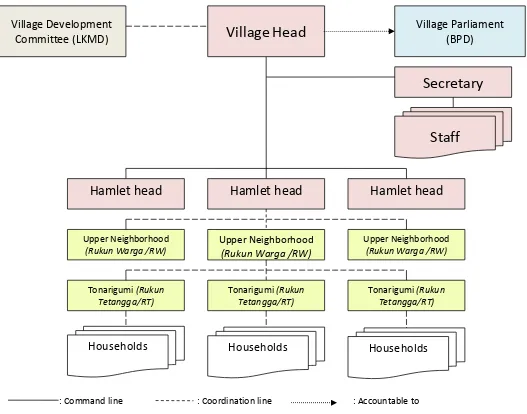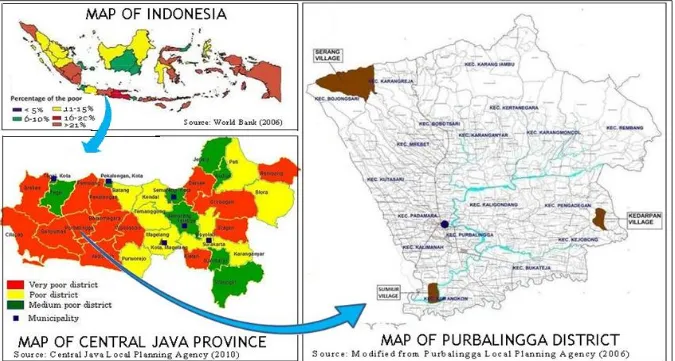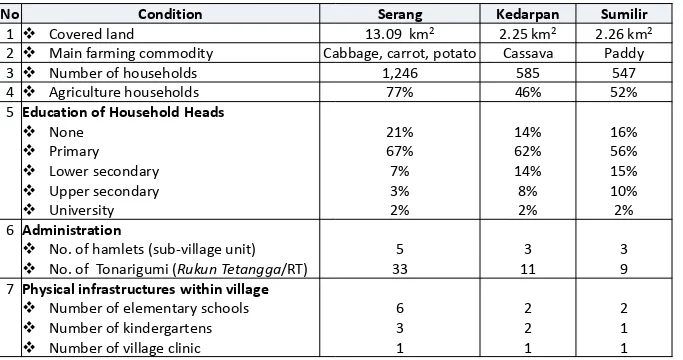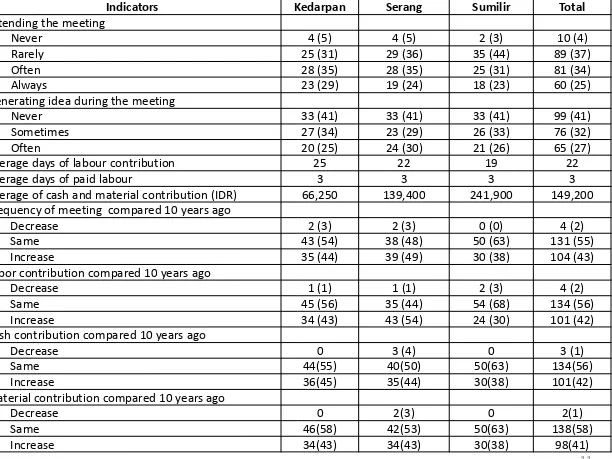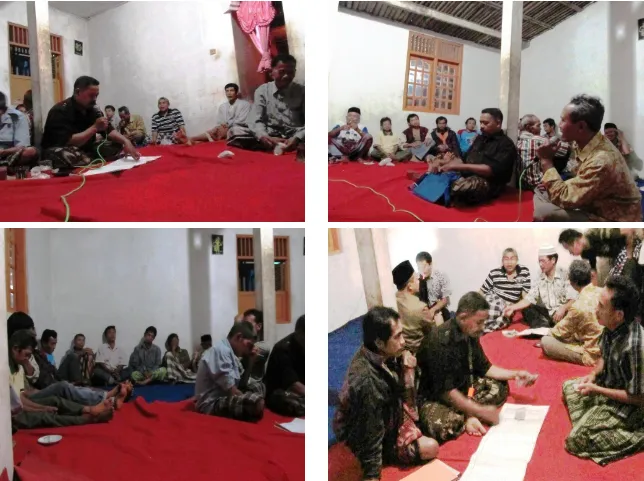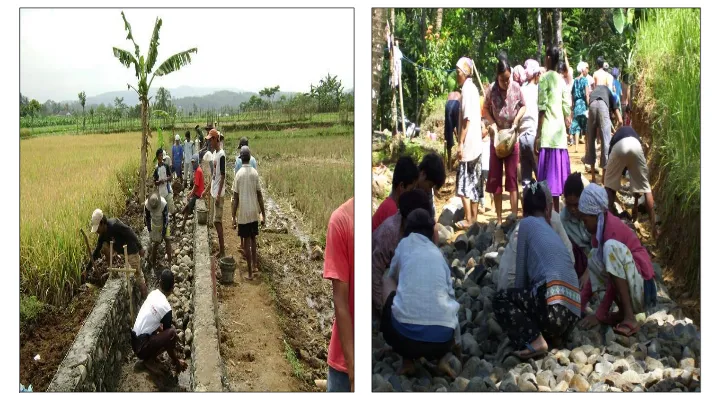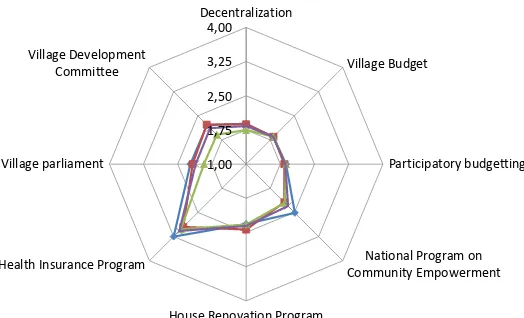Roles of
Tonarigumi
to Promote
Participatory Development in Indonesia:
Case of Three Villages in Purbalingga District,
Central Java Province
By: Sutiyo
District Government of Purbalingga,
Central Java Province, Indonesia
1. Introduction
After the collapse of Suharto regime, in 2001, the government of Indonesia launched decentralization.
This moment make a fundamental shift in rural development policy,
from top-down to bottom up approach.
The success of decentralization and participatory development requires an enabling rural institutional environment.
This study aims to analyze implementation of decentralization at the
lowest level of administration, namely Tonarigumi (Rukun Tetangga/RT). Whether this institutions can promote participatory rural development is the central question in this study.
Analyzing roles of an institution in participatory development requires attention to specific processes, which include: The ways in which
community is involved in rural development; The leadership capacity of institution heads in executing their tasks; and the impact of those
processes on community empowerment.
2. Literature Reviews
Tonarigumi (Rukun Tetangga/RT) is a neighborhood group comprising about
fifty households living in the same area. The head is elected by community.
It was originally established by Japanese army during World War II to control
people, foster self-help and mobilize logistic for war (Kobayashi, 2007).
Although the war was ended in 1945, tonarigumi structure continued to exist.
The government made it a mandatory organization throughout Indonesia.
In fact, tonarigumi plays dual roles, either as a community organization or as a
pseudo governmental institution.
As community organization, it’s tasks include collecting garbage, conducting
night patrol, holding funerals and maintaining infrastructure (Dwianto,2003;
Grootaert,1999).
As a pseudo administrative institution, its tasks include collecting property
taxes, reporting demographic data and connecting the communication between community and village head (Antlöv, 2000).
With regard to participatory development, it has tasks to conduct villagers
: Command line : Coordination line : Accountable to
Hamlet head Hamlet head
Village Parliament
Households Households Households Staff
Figure 1. Structure of Village Government
As the lowest level of administration, tonarigumi plays important roles both for government and community.
During Suharto regime, Antlöv (1995) finds that participatory processes in Tonarigumi was just a formality. Tonarigumi just became a tool of the state to collect taxes and mobilize cash and labour.
Grootaert (1999) finds that community perceived tonarigumi as one of the most important institutions helping their livelihood problems. Most tonarigumies had monthly meeting to discuss local issues like road
maintenance, infrastructure reparation, religius ceremonies and local festive.
Evers (2000) finds that within village area, community initiatives and collective actions were focused and limited within tonarigumi. This was because community had no formal instrument to influence village head and trust between them was low.
Fieldwork was conducted in Serang, Kedarpan and Sumilir villages in
Purbalingga District, during June to July 2014. 8 tonarigumies in each village
and 10 households from each tonarigumi were selected. Total respondents
were 240 households.
Respondent’s perception is arranged from poor (score 1), slightly poor (score
2), good enough (score 3) and good (score 4). A mean is created by dividing total scores by total respondents. The interpretation of the mean is:
1-1.74: poor; 1.75-2.49: slightly poor; 2.5-3.24: good enough; 3.25-4: good
To measure the capacity of tonarigumi heads, this study uses indicators
created by Sutiyo and Maharjan (2014), which are derived from combination of
leadership concept and traditional roles of leader in Javanese society. The indicators are informativeness, responsiveness, encouragement, creativity, fairness, accountability, submission to consensus
With regard to community empowerment, this study emphasized
empowerment as a process to improve villager’s skill to participate in
decentralization. Measurement was based on proxies of understanding on
terms of decentralization, government programs and some village institutions.
6
8
No Condition Serang Kedarpan Sumilir
1 Covered land 13.09 km2 2.25 km2 2.26 km2
2 Main farming commodity Cabbage, carrot, potato Cassava Paddy
3 Number of households 1,246 585 547
4 Agriculture households 77% 46% 52%
5 Education of Household Heads
None 21% 14% 16%
4.1. Description of Research Locations and Respondents
Table 1. Profile of Study Villages
Table 3. Profile of Respondent
No Profile Village Total
Kedarpan Serang Sumilir
1
4.2. Community participation in tonarigumi
17 tonarigumies had periodic meeting, mostly monthly. 2 tonarigumies in Serang and 3 tonarigumies in Sumilir held meeting as per need. In
Kedarpan, 2 tonarigumies never arranged meeting for years.
Most respondents (59%) often or always came to attend the meeting. However, most of them never generated idea, and just came as listener.
Resources mobilization was high.
Days of labour contribution were averagely 22 days per year. Most activities were routinely scheduled, e.g. once a month to clean road, early rainy season to maintain irrigation, once a year to maintain cemetery, public well and mosque.
Cash contribution was averagely IDR 149,183 a year. This amount was equivalent to a wage of 4 days-labour.
Social pressure, in which a villager was fearful of being criticized by
neighbors, was part of the motivating factor to contribute cash and labour.
Most respondent perceived that participation was the same as ten years ago. However, substantial number of respondent perceived that it was increased
Table 4. Community Participation in Tonarigumi
No Indicators Kedarpan Serang Sumilir Total
1
Attending the meeting
Never 4 (5) 4 (5) 2 (3) 10 (4)
Rarely 25 (31) 29 (36) 35 (44) 89 (37)
Often 28 (35) 28 (35) 25 (31) 81 (34)
Always 23 (29) 19 (24) 18 (23) 60 (25)
2
Generating idea during the meeting
Never 33 (41) 33 (41) 33 (41) 99 (41)
Sometimes 27 (34) 23 (29) 26 (33) 76 (32)
Often 20 (25) 24 (30) 21 (26) 65 (27) 3 Average days of labour contribution 25 22 19 22 4 Average days of paid labour 3 3 3 3 5 Average of cash and material contribution (IDR) 66,250 139,400 241,900 149,200
6
Frequency of meeting compared 10 years ago
Decrease 2 (3) 2 (3) 0 (0) 4 (2)
Same 43 (54) 38 (48) 50 (63) 131 (55)
Increase 35 (44) 39 (49) 30 (38) 104 (43)
7
Labor contribution compared 10 years ago
Decrease 1 (1) 1 (1) 2 (3) 4 (2)
Same 45 (56) 35 (44) 54 (68) 134 (56)
Increase 34 (43) 43 (54) 24 (30) 101 (42)
8
Cash contribution compared 10 years ago
Decrease 0 3 (4) 0 3 (1)
Same 44(55) 40(50) 50(63) 134(56)
Increase 36(45) 35(44) 30(38) 101(42)
9
Material contribution compared 10 years ago
Decrease 0 2(3) 0 2(1)
Same 46(58) 42(53) 50(63) 138(58)
Increase 34(43) 34(43) 30(38) 98(41)
4.3. Capacity of Tonarigumi Heads
Most indicators of leadership capacity, like informativeness, submission to consensus, responsiveness, encouragement, creativity and fairness were good enough. Yet,
accountability was slightly poor (Figure 6).
Tonarigumi heads were perceived informative enough, in which they informed and socialized government programs to villagers in tonarigumi meeting.
Any decision made during the meeting was followed by the tonarigumi head, thus submission to consensus was perceived good enough.
Tonarigumi was the lowest institution dealing with daily community problems and complaints. Tonarigumi heads were perceived responsive enough to those problems.
Creativity was perceived a little bit low since the way to solve problems was without innovation.
During project implementation, tonarigumi head motivated and encouraged villagers to voluntarily contribute labor.
Tonarigumi head was perceived fair enough, in which they treated every villagers without discrimination.
Community were rarely given report of village budget. Information about name of
programs and what the villagers should do was given before the projects. Yet, after the projects finished, report of budget utilization were rarely shared. Thus, accountability was perceived slightly poor
Figure 6. Community Perception on Leadership of Tonarigumi Heads Source: Field survey, 2014
1,00 1,75 2,50 3,25 4,00
Informativeness
Submission to consensus
Responsiveness
Encouragement Creativity
Fairness Accountability
4.4. Community Empowerment through Tonarigumi
Community empowerment did not effectively happen in tonarigumi . After 10 years of decentralization, community still had low understanding on
decentralization
Community understanding on terms of decentralization (Otonomi Daerah), which was broadly quoted in Indonesia, and participatory budgeting
(Musrenbang), which was annually held, were slightly low.
Understanding on some major development programs, like National Program for Community Empowerment (Program Nasional Pemberdayaan
Masyarakat), House Renovation Program (Program Pemugaran Rumah Miskin), and Village Budget (Dana Alokasi Desa) were slightly low. Most respondents just ever heard the program, but did not know the meaning,
program recipients, amount of fund and its utilization. Whereas, the programs were implemented in their villages.
Understanding on matters related to village government, like Village
Parliament (Badan Permusyawaratan Desa / BPD) and Village Development Committee (Lembaga Ketahanan Masyarakat Desa / LKMD) were low. Most respondent did not know members of these institutions and their tasks.
Figure 7. Respondent’s Understanding on Decentralization Matters Source: Field survey, 2014
1,00
5. Discussion
Generally, this study finds that community involvement is pseudo participation emphasizing more on resource mobilization but less in decision making. Leadership capacity of tonarigumi heads is good enough, but with low scores in accountability and creativity. Thus, it is not surprising that community empowerment does not effectively happen
Tonarigumi, as pseudo administrative institution, is not completely successful in promoting participatory development. This was contrary to the findings of Grootaert (1999) and Evers (2000), where
tonarigumi as a community groups, could help villagers solve their livelihood problems.
Yet, some potentialities is identified. For example, most tonarigumies held scheduled meeting, substantial number of respondent perceived that participation is increased in the last ten years, or during
decentralization. Tonarigumi heads also have performed their role as a good enough community leader.
Discussion continued
Policy of decentralization and participatory development should be continued. What the government should do is to optimize the
potentialities of tonarigumi
Looking at the current conditions of tonarigumi, there are two options can be done for improving the success of decentralization
The first is to develop the capacity of tonarigumi head, so that they can practice accountability, improve creativity and transfer their knowledge on decentralization to community
The second, hand in hand with capacity development to
tonarigumi heads, the government should not limit the bottom-up proposal and participatory development only through tonarigumi. The other institution in rural areas should be involved to
6. Conclusion and Policy Recommendation
Tonarigumi is not completely successful in promoting participatory rural development.
Capacity development should be delivered to tonarigumi heads.
Hand in hand with this, the government should involve the other rural institutions to complement the roles cannot be played by tonarigumi
Acknowledgement
The author would like to thank to the Sumitomo Foundation
of Japan, which provides research grant for this study
References
Antlöv, H. (1995). Exemplary Center, Administrative Periphery. Rural Leadership and the New Order in Java. London: Curzon Press. . London: Curzon Press.
Antlöv, H. (2000). Village Governance in Indonesia: Past, Present and Future Challenges. Paper presented at the Conference on Dynamic of Local Politic in Indonesia, Yogyakarta.
Dwianto, R. D. (2003). The Existing Form of Urban Locality Groups in Jakarta: Reexamining the RT/RW in the post-New Order Era. In T. Mizuchi (Ed.),
Representing Local Places and Rising Voices from Below (pp. 41-60). Osaka: Osaka City University.
Evers, P. J. (2000). Resourceful Villagers, Powerless Communities (Rural Village Government in Indonesia). Jakarta: The World Bank Indonesia.
Grootaert, C. (1999). Social Capital, Household Welfare and Poverty in Indonesia. Washington D. C. : World Bank.
Kobayashi, K. (2007). The “Invention of Tradition” in Java under the Japanese
Occupation: The Tonarigumi System and Gotong Royong. Shiga-Japan: Afrasian Centre for Peace and Development Studies.
